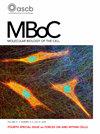The prolyl isomerase FKBP11 is a secretory translocon accessory factor.
IF 3.1
3区 生物学
Q3 CELL BIOLOGY
引用次数: 0
Abstract
Eukaryotic cells encode thousands of secretory and membrane proteins, many of which are cotranslationally translocated into or across the endoplasmic reticulum (ER). Nascent polypeptides entering the ER encounter a network of molecular chaperones and enzymes that facilitate their folding. A rate-limiting step for some proteins is the trans-to-cis isomerization of the peptide bond between proline and the residue preceding it. The human ER contains six prolyl isomerases, but the function, organization and substrate range of these proteins is not clear. Here we show that the metazoan-specific, prolyl isomerase FKBP11 binds to ribosome-translocon complexes (RTCs) in the ER membrane, dependent on its single transmembrane domain (TMD) and a conserved, positively charged region at its cytosolic C-terminus. High throughput mRNA sequencing shows selective engagement with ribosomes synthesizing secretory and membrane proteins with long translocated segments, and functional analysis shows reduced stability of two such proteins, EpCAM and PTTG1IP, in cells depleted of FKBP11. We propose that FKBP11 is a translocon accessory factor that acts on a broad range of soluble secretory and transmembrane proteins during their synthesis at the ER.脯氨酰异构酶 FKBP11 是一种分泌性转座子附属因子。
真核细胞编码了数千种分泌蛋白和膜蛋白,其中许多都是通过共翻译转运进入或穿过内质网(ER)的。进入内质网的新多肽会遇到一个由分子伴侣和酶组成的网络,从而促进它们的折叠。某些蛋白质的一个限速步骤是脯氨酸和它前面的残基之间肽键的反式-顺式异构化。人类ER含有六种脯氨酰异构酶,但这些蛋白的功能、组织和底物范围尚不清楚。在这里,我们发现元祖类特异性脯氨酰异构酶 FKBP11 能与 ER 膜上的核糖体-转录因子复合体(RTC)结合,这依赖于它的单跨膜结构域(TMD)和位于细胞质 C 端的保守的正电荷区域。高通量 mRNA 测序显示,FKBP11 可选择性地参与核糖体合成具有长转运片段的分泌蛋白和膜蛋白,功能分析显示,在缺失 FKBP11 的细胞中,EpCAM 和 PTTG1IP 这两种蛋白的稳定性降低。我们认为,FKBP11 是一种转座子辅助因子,可在多种可溶性分泌蛋白和跨膜蛋白在 ER 合成过程中发挥作用。
本文章由计算机程序翻译,如有差异,请以英文原文为准。
求助全文
约1分钟内获得全文
求助全文
来源期刊

Molecular Biology of the Cell
生物-细胞生物学
CiteScore
6.00
自引率
6.10%
发文量
402
审稿时长
2 months
期刊介绍:
MBoC publishes research articles that present conceptual advances of broad interest and significance within all areas of cell, molecular, and developmental biology. We welcome manuscripts that describe advances with applications across topics including but not limited to: cell growth and division; nuclear and cytoskeletal processes; membrane trafficking and autophagy; organelle biology; quantitative cell biology; physical cell biology and mechanobiology; cell signaling; stem cell biology and development; cancer biology; cellular immunology and microbial pathogenesis; cellular neurobiology; prokaryotic cell biology; and cell biology of disease.
 求助内容:
求助内容: 应助结果提醒方式:
应助结果提醒方式:


